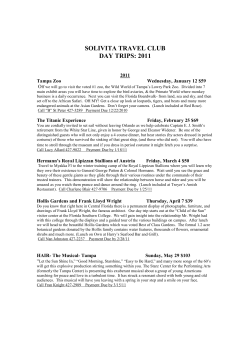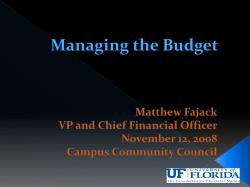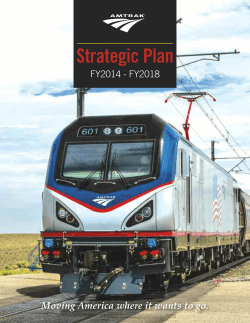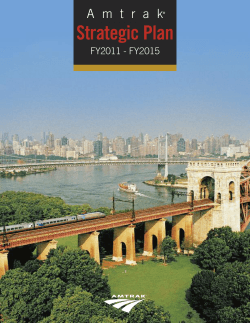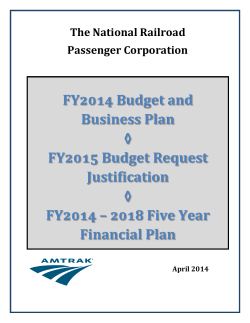
Rail Prevails: Orlando’s SunRail Set to Become Central
Summer 2012 Rail Prevails: Orlando’s SunRail Set to Become Central Florida’s First Modern Rail System By Scott Bogren Last month, a group of local, state and federal elected officials, with requisite members of the media in tow, gathered in DeBary, Florida beneath a white tent protecting them from Florida’s hot mid-day sun. They gathered to officially and ceremoniously break ground at what promises to be, some 15 months hence, the DeBary Station on SunRail — Central Florida’s first modern rail system. Work is currently underway on SunRail’s first section — a 31-mile segment stretching from DeBary north of Orlando down into the city and then south to Sand Lake Road — which is due to go on-line on May 1, 2014. www.railmagazine.org Eventually, plans call for the line to extend north to DeLand and south to Poinciana. All told, it’s an ambitious $1.3 billion project that somehow prevailed over a fractious local and state political climate that recently saw Florida Governor Rick Scott turn away billions of federal dollars for high-speed rail while an initiative to build light rail in the nearby Tampa/St. Petersburg area failed at the polls. “We need to make sure this is not the end of the line,” said U.S. Congressman John Mica, at the ceremony. “Our vision is to go north, south, east and west.” CONTENTS Previous Page Against the Odds: SunRail Prevails Five years ago, the SunRail project currently being constructed became more than a concept or even a plan on paper. In July 2007, officials from Orange, Volusia, Osceola and Seminole Counties, as well as those from the city of Orlando, officially and unanimously approved the SunRail project by entering into agreements both with each other and with the Florida Department of Transportation (FDOT). These interlocal agreements include commitments by FDOT and the counties and city to fund half of the capital improvements, all of 28 Next Page the anticipated operating and maintenance deficit and to create the governance structure that eventually was named SunRail. This vote came four months after the Federal Transit Administration had sent project officials an approval letter to enter into preliminary engineering. Next up for SunRail was acquiring the line’s right of way. In November, 2007, FDOT and CSX — which owned the line — agreed in principal to the line’s sale, pending approval by the Florida State Legislature. The initial agreement called for the state of Florida; Orange, Volusia, Osceola and Seminole Counties; and the city of Orlando to pay $491 million for the 61-mile stretch of track. Track maintenance and dispatching under the arrangement would be transferred to the South Florida Regional Transportation Authority — which operates South Florida’s Tri-Rail. Finally, the FDOT-CSX agreement covered unspecified investment in rail freight infrastructure to improve its efficiency statewide, and a $10 million annual payment from CSX in exchange for limited freight transportation on both the South Florida and SunRail lines. The local funding partners for SunRail include the four counties — Orange, Volusia, Osceola www.railmagazine.org and Seminole — along with the city of Orlando. These five have agreed to fund a quarter of the project’s costs, with the state of Florida picking up another 25 percent and the Federal Transit Administration’s New Starts project accounting for the final 50 percent. Construction costs for SunRail have been estimated at $615 million, with another $432 million going to purchase the right-of-way. There was, however, a caveat to the agreement; one from CSX that stated that by 2009, the Florida State Legislature must approve legislation that included some of the key points in the agreement. In May 2008, the legislature failed to do so, putting the entire SunRail program in jeopardy. Initially, state lawmakers in areas that would see increased freight traffic due to the sale raised objections. Yet it was an obscure part of the sale that shielded CSX from liability from accidents involving passengers that proved a more significant impediment. SunRail officials and commuter rail advocates hoped that the 2009 state legislative session would treat the project better, and see the FDOT-CSX agreement passed. On April 30 of that year the project was once again defeated, again with the insurance issue standing front-and-center as the key obstruction. With its deadline looming, CSX relented and offered additional time for negotiation. In December 2009, the stalemate was broken as agreement on the indemnification/insurance issue was reached. All seemed, at long last, complete. That is, until negotiations with Amtrak on the sale broke down, once again along the liability CONTENTS Previous Page Rail is currently being installed on the line. A LYNX bus, designed to mimic the SunRail livery. Station work is underway all along the corridor. 29 Next Page www.railmagazine.org 61-mile/17 station SunRail System Map P 44 44 DeLand DeLand Orange City Stations P Parking Provided 472 4 Maintenance Facility Option L 4145 Saxon Blvd Layover Facility Option 17 Deltona 92 Phase 1 Alignment Phase 2 North Alignment 44 Phase 2 South Alignment St DeBary P iv sR hn Jo er LAKE CO. SANFORD AIRPORT ORANGE CO. Airp Sanford ort B OR AN SE GE MIN CO OL EC O Lake Mary Blvd 441 415 Sanford SEMINOLE LAKE CO. CO. Lake Monroe VOLUSIA CO. SEMINOLE CO. P 46 lvd Lake Mary P TOLL 417 4 ke La 17 92 p Jesu Longwood P 434 Altamonte Springs 436 Longwood Winter Springs Semino P Semoran Blvd la Blvd Altamonte Springs Maitland Maitland Blvd 434 TOLL P 429 Semoran Colonial Dr Lynx Central Church Street Orlando Amtrak/Sligh Blvd TOLL 408 John Young Pkwy Orlando 50 Lake Underhill Rd Curry Ford Rd TOLL 417 436 Sand Lake Rd TOLL L P Sand Lake Road 528 423 535 SEMINOLE CO. ORANGE CO. Winter Park Dr ColonialVillage Florida Hospital Health Princeton St 435 434 Winter Park Fairbanks Ave 438 Oviedo Maitland Lee Rd Blvd Lake Apopka 15 Orange Blossom Trail funding for a project that a previous legislature had approved. High-speed rail was, at least for the time being, finished in Florida and the prospects for SunRail seemed dim. In yet another turn in fortunes for SunRail, on July 1, 2011, the Florida DOT announced that Governor Scott had accepted the project. Congressman Mica said at the time: ““I think the governor did what a smart business person does, look at the bottom line and the bottom line is jobs, it’s the economy, it’s a cost effective transportation system for the future.” Later that month, the FDOT and the Federal Transit Administration signed a full-funding grant agreement for SunRail’s phase 1. “Today’s event [signing the full funding grant agreement] is a critical step toward SunRail moving forward. It commits the federal government and the State to getting SunRail built and operating,” said Florida DOT Secretary Ananth Prasad. “But more importantly, the pledges from all the local partners and the many businesses will once again reinforce their commitment to doing all they can to ensure SunRail’s success.” John Young Pkwy issue. It wasn’t until December 2010 that this latest impasse was broken and the sale went through. At the time of the sale, Congressman John Mica, Chair of the House Transportation and Infrastructure Committee, noted: “The transfer of the CSX rail corridor to the State of Florida marks a significant milestone in completing the SunRail project. Today, the people of Florida acquired valuable rail rightof-way. which both makes SunRail possible and marks the beginning of actually turning dirt and putting people to work.” “From today forward, Florida will receive payments from anyone, including CSX, Amtrak and others who use the line, rather than pay rent or lease the track for years to come. With this step, contracts will be confirmed, construction will begin and many people in Central Florida will have employment opportunities and jobs now rather than later.” With the sale at long last finalized, SunRail seemed all systems go. But a new potential hurdle had emerged with the election in November 2010 of Florida Governor Rick Scott. In his first month of office Governor Scott ordered the SunRail project and all of its contracts frozen, pending a six-month evaluation to determine whether or not it was a good investment. A month later, Scott rejected $2.3 billion in federal high-speed rail investment connecting Tampa and Orlando, pointing to predicted cost overruns and concerns about the line’s ridership. In March 2011, the Florida Supreme Court agreed with Governor Scott, ruling that he had the authority to reject P Meadow Woods 441 536 Osceola Pkwy P TOLL 417 ORANGE CO. OSCEOLA CO. 192 4 P OSCEOLA CO. POLK CO. Osceola Parkway Kissimmee Kissimmee Amtrak East Lake Tohopekaliga Poinciana 17 P L 192 532 Lake Tohopekaliga The SunRail Line SunRail will be built in two distinct construction phases. The first phase will take the corridor from DeBary north or Orlando through to a park-and-ride at the Sand Lake Road station in southern Orlando. In all, 17 stations are planned for the built-out SunRail, with 12 being ready for system’s projected launch in 2014. The corridor’s second phase CONTENTS Previous Page will add DeLand to the north and four stations south of Orlando in Osceola County, including both Kissimmee and the southern terminus in Poinciana. A key station for SunRail – and one with a fascinating history — will be the downtown station that will be known as Orlando Health/ Amtrak on Sligh Boulevard. This 1920s-era Spanish-mission station was originally built 30 Next Page for the Atlantic Coast Line railroad and was used by the Seaboard Coast Line railroad in the 1960s. The historic station enjoyed a revitalization in the 1990s when it was selected for the city’s Adopt-a-Spot program where some 1,200 volunteers spent time refurbishing and painting the structure. Amtrak’s Silver Meteor and Silver Star service call on the Amtrak station, which was also the eastern end of the Sunset Limited until Hurricane Katrina abbreviated that route to New Orleans. The station’s name — Orlando Health/Amtrak — also points to one of the key connections SunRail will make in terms of employment destinations. The adjacent health care nexus includes the Orlando Regional Medical Center, M.D. Anderson Cancer Center, the Ambulatory Care Center, Arnold Palmer Children’s Hospital, Winnie Palmer Hospital for Women and Babies and the Lucerne Hospital. Orlando Health is expected to employ more than 19,000 people in the coming years, in addition to have more than 2,000 hospital beds. The Orlando Health/Amtrak stop is not the only SunRail station with a distinct health care emphasis. Another — the Florida Hospital Station — is being built through a partnership between the community and Florida Hospital, a 900-bed acute care community hospital. The hospital expects to invest more than $230 million in new facilities within the next five years, as well as create a Health Village on campus. The southern terminus of SunRail’s phase one will be a park-and-ride station at Sand www.railmagazine.org All Aboard Florida In the late 1800s, Henry Flagler built one of the world’s most ambitious railroads on Florida’s east coast, extending from Jacksonville to Miami and ultimately to Key West. While doing so, Flagler also established his Florida East Coast Railway as one of the industry’s pioneers in rail-oriented development, a century before the term was even coined. Although Flagler passed away in 1913 – just a year after his signature Florida Overseas Railroad was completed to Key West – his legacy lives on today in the freight rail services of Florida East Coast Enterprises (FECI) and its real estate development arm, Flagler Development and its once-again ambitious All Aboard Florida plan to restore frequent, higher-speed passenger rail service from Miami to Orlando. When Florida Governor Rick Scott ended the state’s role in developing a high-speed rail line between Tampa and Orlando, FEC moved quickly to maintain momentum for revitalized passenger rail service in the state. In March 2012, FECI announced the All Aboard Florida project that will use the railroad’s existing infrastructure between Miami and Cocoa and establish a new line from Cocoa to Orlando to provide three hour trips between Miami and Orlando by 2014. Since the railroad has utilized positive train control (PTC) on its full route between Jacksonville and Miami since 1987, All Aboard Florida trains will be able to operate at speeds above the federally-mandated 79 miles-per-hour speed limit when PTC is not installed. Moreover, FECI already operates its freight trains at higher-than-average speeds – often up to 60 miles-per-hour, the line has available capacity to include passenger trains along with existing freight service. The service would make the first effort by a privately-owned freight railroad to directly provide scheduled, daily passenger rail service in the United States since the mid-1970s without a contract or subsidy. Initially, two intermediate stops are planned beyond the Orlando and Miami terminals at Fort Lauderdale and West Palm Beach, and the service is expected to attract more than 3 million riders per year while also creating 6,000 construction jobs and 1,000 permanent jobs following completion. FECI is currently conducting fiscal and engineering studies to prepare for construction, and negotiating both a right-of-way to Orlando from Cocoa as well locations for all four stations. The company already owns land adjacent to its rail line in downtown Miami where connections could also be made to Miami’s Metrorail and Metromover systems. In Orlando, All Aboard Florida trains are expected to link with SunRail commuter trains as well as provide access to the Orlando International Airport. CONTENTS Previous Page 31 Next Page Lake Road, which will be designed to provide access to the Florida Mall and to the Orlando International Airport. Along the way, SunRail will connect with Amtrak’s Silver Service in Winter Park, and is close to the Amtrak Autotrain’s southern terminus in Sanford. For bus service, SunRail offers direct connectivity with Volusia County’s Votran System, Orlando’s Lynx transit system and the planned All Aboard Florida service in Orlando. SunRail Becomes More Than a Concept In January, ground was broken on the Altamonte Springs Station, thus inaugurating the construction phase of SunRail. Florida DOT Secretary, at the event, said: ”This is the beginning of a new chapter in transportation in Orlando and Central Florida.” Next, in March, new sections of steel rail were delivered to the line. In May, maintenance work along a seven-mile stretch of the corridor began. Right now, plans are for SunRail trains to operate every 30-minutes during peak morning (5:30 a.m. – 8:30 a.m.) and afternoon (3:30 p.m. – 6:30 p.m.) commute periods; and at two-hour intervals during non-peak hours. As for rolling stock, SunRail has already contracted with MotivePower for seven 3,000 horsepower, rebuilt locomotives, and 14 bi-level rail coaches from Bombardier. The agency has options to buy more of both, if and when that is necessary. The idea of SunRail has endured through www.railmagazine.org a difficult political process and through the tribulations that often accompany the (re) introduction of passenger rail into a community. And SunRail has prevailed not only because it holds both mobility and economic promise for one of the nation’s fastest growing regions, but more directly due to the strength of its local advocates — be they elected officials, business leaders or commuters. It comes as no surprise that scalable, cost-effective commuter rail operations like SunRail have been the harbingers of larger passenger rail and transit networks in other communities. CONTENTS Previous Page A rendering of SunRail’s Bombardier-built BiLevel coaches (above); Orlando’s historic Seaboard Coast Line station (below). 32 Next Page
© Copyright 2025


